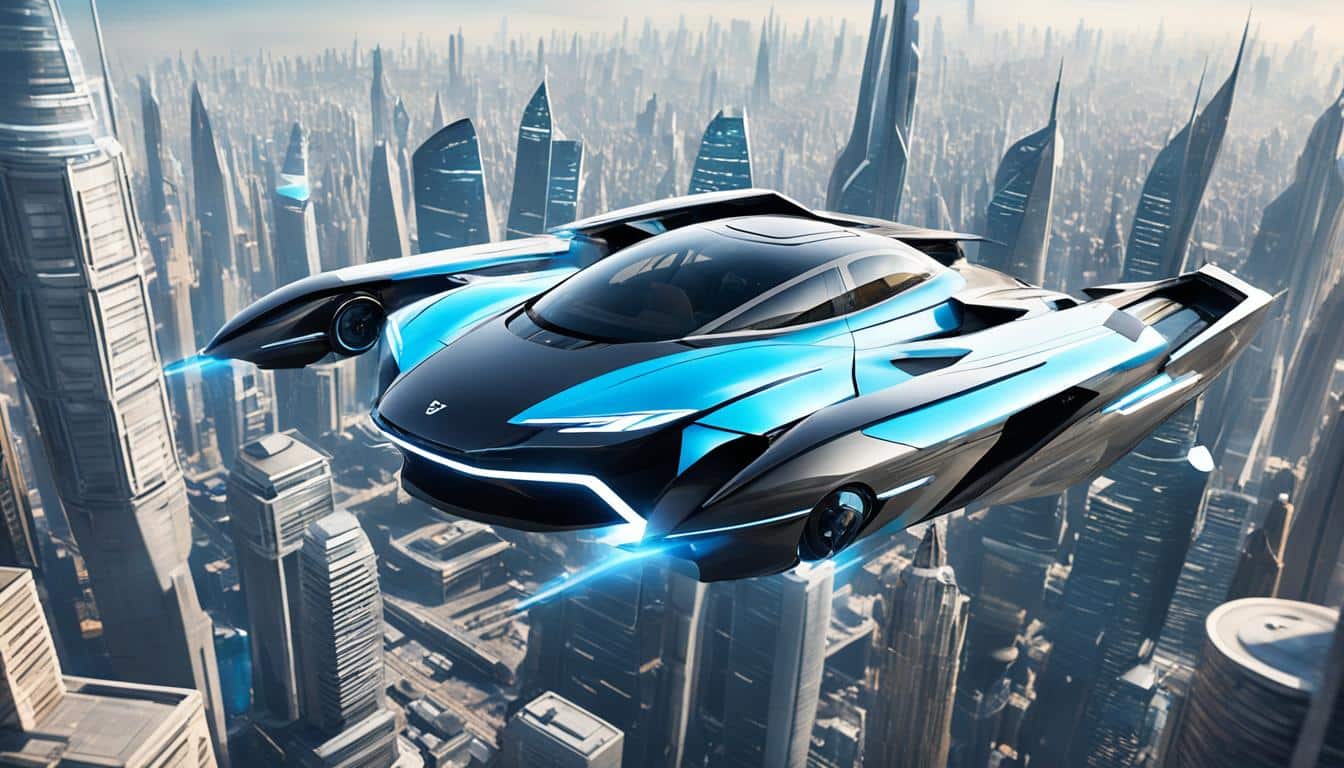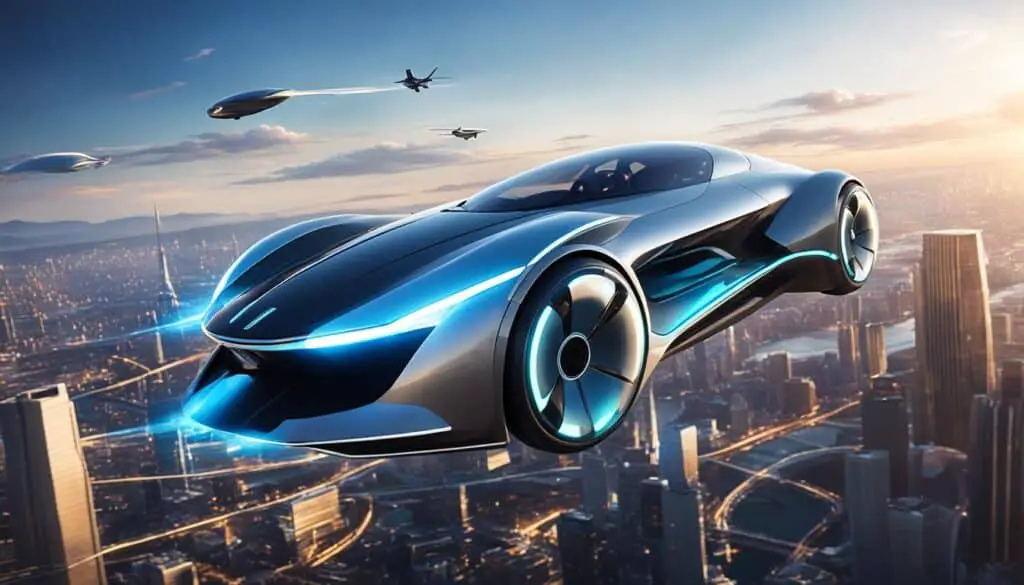
Flying Cars: Soaring into the Future of Mobility
Flying cars are revolutionizing the way we think about transportation, offering a glimpse into the future of mobility. With advancements in technology and design, these vehicles are poised to transform travel as we know it. Let’s explore the role of flying cars in shaping the future of mobility.
Key Takeaways:
- Flying cars have the potential to revolutionize transportation and mobility.
- Advancements in technology and design are driving the development of flying cars.
- Flying cars can alleviate urban traffic congestion and improve urban transportation.
- Safety and regulatory challenges need to be addressed for the widespread adoption of flying cars.
- The environmental impact of flying cars must be carefully considered.
The Potential of Flying Cars in Urban Transportation
One of the key advantages of flying cars is their potential to alleviate the problem of urban traffic congestion. By taking to the skies, these vehicles can bypass traditional roadways, reducing travel times and easing congestion on the ground. This could lead to more efficient and seamless urban transportation, improving the overall mobility of city dwellers.
The Impact of Flying Cars on Urban Transportation
Urban transportation is a pressing issue in today’s cities. Congestion on the roads has a significant impact on productivity, air quality, and quality of life for residents. Traditional modes of transportation, such as cars and public transit, are often limited by the existing road infrastructure and can only accommodate a certain number of vehicles at a time.
Flying cars offer a potential solution to these challenges by introducing a new dimension to urban transportation – the sky. By taking advantage of aerial mobility, flying cars can bypass congested roadways and transport passengers directly to their destinations, avoiding the typical traffic jams that plague city streets.
The benefits of flying cars in urban transportation are numerous. First and foremost, they have the potential to greatly reduce travel times. With the ability to fly in a straight line from point A to point B, flying cars can bypass detours and congested areas, allowing passengers to reach their destinations faster than ever before.
In addition to reducing travel times, flying cars can also help alleviate traffic congestion on the ground. By taking to the skies, these vehicles remove themselves from the flow of on-the-ground traffic, freeing up road space for other vehicles and reducing the overall congestion on the roads. This can have a positive ripple effect, improving traffic flow and reducing the frustration and stress associated with sitting in traffic.
The Potential of Aerial Mobility
Furthermore, the introduction of flying cars in urban transportation has the potential to revolutionize how cities are designed and built. With the ability to travel in three dimensions, cities may no longer need to rely on wide road networks and sprawling parking lots, leading to more compact and efficient urban environments.
However, it’s important to note that the widespread adoption of flying cars in urban transportation is not without its challenges. There are many technical, regulatory, and infrastructure hurdles that need to be overcome for flying cars to become a viable mode of transport. These include issues such as air traffic management, safety regulations, and the establishment of a reliable charging and refueling infrastructure.
Advances in Technology Driving the Development of Flying Cars
Technological advancements play a pivotal role in propelling the development of flying cars, bringing us closer to a future of airborne mobility. These advancements encompass electric propulsion and autonomous flight, revolutionizing the way we envision transportation. Let’s explore how these breakthroughs are paving the way for the realization of flying cars as a viable option for future mobility.
An Evolution in Propulsion: Electric Motors
Electric propulsion is a key technological advancement driving the development of flying cars. Traditional combustion engines, with their reliance on fossil fuels, contribute to pollution and resource depletion. In contrast, electric motors provide a cleaner and more sustainable alternative, reducing carbon emissions and ensuring a greener future.
With their high power-to-weight ratios and efficient energy consumption, electric motors offer the necessary thrust for flying cars to navigate the skies. Additionally, advancements in battery technology have extended the range and flight time of electric vehicles, making them a practical choice for aerial transportation.
“Electric propulsion is a game-changer in the world of flying cars, offering a greener and more sustainable mode of transportation.”
Autonomous Flight: Paving the Way for Safe and Efficient Travel
Another significant technological advancement is the integration of autonomous capabilities in flying cars. Autonomous flight systems utilize cutting-edge sensors, artificial intelligence, and machine learning algorithms to enable safe and efficient navigation through the skies.
These autonomous systems provide real-time data analysis, allowing flying cars to make autonomous decisions and respond to changing conditions. By eliminating the need for human pilots, autonomous flight not only enhances safety but also opens up new possibilities for streamlined and efficient air travel.
Embracing autonomous flight technology requires overcoming complex challenges, including the development of robust communication systems and establishing rigorous safety standards. However, as advancements in artificial intelligence continue to progress, the vision of autonomous flying cars is becoming an attainable reality.
The Synergy of Technological Advancements
The convergence of electric propulsion and autonomous flight technology is the driving force behind the rapid development of flying cars. By combining these technological advancements, engineers and innovators are pushing the boundaries of what is possible in aerial mobility.
Electric propulsion offers a sustainable and efficient means of flight, while autonomous systems enhance safety and enable autonomous operation. Together, these advancements make flying cars a viable option for future mobility, offering the potential to transform travel and improve urban transportation.
As technological advancements in electric propulsion and autonomous flight continue to evolve, the era of flying cars is not far from reality. However, further development, testing, and regulatory considerations are essential to ensure the safe integration of these aerial vehicles into our everyday lives.

Stay tuned for the next section where we dive into the safety and regulatory challenges of flying cars.
Safety and Regulatory Challenges of Flying Cars
When it comes to incorporating flying cars into our transportation system, addressing safety and regulatory challenges is of paramount importance. Like any new form of transportation, flying cars need to meet stringent safety standards to ensure the well-being of passengers and the general public.
Airspace Management: A key challenge in the integration of flying cars is effectively managing the airspace. With an increasing number of vehicles taking to the skies, it becomes crucial to develop systems and protocols for smooth and safe navigation. This includes establishing designated flight paths, implementing air traffic control systems, and preventing airspace congestion.
Collision Avoidance: With multiple vehicles flying in close proximity, collision avoidance becomes a critical concern. Advanced sensor technologies and sophisticated algorithms can play a vital role in detecting and avoiding potential collisions. Ensuring that flying cars have reliable collision avoidance systems is essential for maintaining safety in the skies.
Regulations and Certifications: To ensure the safe operation of flying cars, comprehensive regulations and certifications must be established. These regulations will cover various aspects, such as vehicle design, manufacturing standards, pilot training, and maintenance requirements. Setting clear guidelines and standards will instill confidence in the public and regulators regarding the safety of flying car operations.
“The safe integration of flying cars into our airspace requires robust safety measures, effective airspace management, and clear regulations.”
Public Perception: Gaining public trust and acceptance is another critical aspect for the successful implementation of flying cars. Addressing concerns related to noise pollution, privacy, and the impact on existing infrastructure will be crucial in shaping public opinion and ensuring the smooth adoption of this transformative mode of transportation.
The Role of Government and Industry Collaboration
Addressing safety and regulatory challenges associated with flying cars requires close collaboration between government agencies and industry stakeholders. By working together, they can develop standards, share best practices, and establish a framework that ensures the safe and efficient integration of flying cars into our transportation system.
Government: Governments play a pivotal role in setting regulations, establishing certification processes, and overseeing the safe implementation of new transportation technologies. By proactively engaging with industry experts, lawmakers can create a conducive environment for innovation while safeguarding public safety.
Industry: Industry stakeholders, including manufacturers, technology providers, and operators, have a responsibility to develop and adhere to stringent safety standards. Investing in research and development, testing, and ongoing safety monitoring will be crucial to instill public confidence and ensure the long-term success of flying car technology.
By addressing safety and regulatory challenges, we can pave the way for a future where flying cars coexist seamlessly with existing transportation modes. These challenges may seem daunting, but with the right technological advancements, collaborative efforts, and a strong commitment to safety, flying cars have the potential to revolutionize the way we travel and transform our cities.
The Impact of Flying Cars on the Environment
Flying cars offer tremendous potential for transforming mobility, but it is vital to consider their environmental impact. While electric propulsion can help reduce carbon emissions, the increased air traffic and energy consumption associated with flying cars may still have environmental consequences.
By utilizing electric motors, flying cars contribute to sustainability by reducing reliance on traditional combustion engines. This transition to electric propulsion reduces carbon emissions and helps mitigate the negative impact on air quality.
However, it is important to recognize that increased air traffic resulting from the widespread adoption of flying cars can lead to greater energy consumption. The energy requirements for air travel are generally higher than those for ground transportation. Therefore, managing the balance between the benefits of flying cars and their impact on the environment becomes essential for achieving sustainable mobility.
To ensure the future of sustainable mobility, it is crucial to develop comprehensive strategies that minimize the environmental impact of flying cars. This includes exploring renewable energy sources for charging flying cars, implementing efficient air traffic management systems, and promoting the use of clean energy for powering these vehicles.
“Balancing the benefits of flying cars with their impact on the environment will be crucial for the future of sustainable mobility.”
Reducing Carbon Footprint
Flying cars powered by electric motors offer a significant advantage in reducing carbon emissions compared to traditional combustion engines. With zero direct emissions, electric propulsion helps mitigate the environmental impact by minimizing greenhouse gases released into the atmosphere.
Furthermore, advancements in battery technology are enhancing the range and efficiency of electric flying cars. This progress allows for longer flights without compromising on sustainability, promoting the adoption and acceptance of flying cars as a viable alternative for future mobility.
Managing Air Traffic and Energy Consumption
The rise of flying cars could potentially lead to an increase in air traffic, raising concerns about energy consumption and its environmental implications. To address this issue, comprehensive air traffic management systems need to be implemented to optimize flight paths, minimize congestion, and reduce overall energy consumption.
Additionally, integrating renewable energy sources into the charging infrastructure for flying cars can further reduce their carbon footprint. Utilizing solar power, for example, can help meet the energy demands of these vehicles while reducing reliance on non-renewable energy sources.

| Environmental Impact Factors of Flying Cars | Strategies for Mitigation |
|---|---|
| Increased air traffic | Develop efficient air traffic management systems to minimize congestion and optimize flight paths. Encourage off-peak travel to reduce overall energy consumption. |
| Energy consumption | Integrate renewable energy sources, such as solar power, into the charging infrastructure of flying cars. Promote the use of clean energy for powering these vehicles. |
| Carbon emissions | Continue advancements in electric propulsion technology to improve energy efficiency and reduce direct emissions. Encourage the adoption of flying cars powered by renewable energy sources. |
Economic Opportunities and Challenges of Flying Cars
The emergence of flying cars presents both economic opportunities and challenges. The development and production of flying cars can create new jobs and stimulate economic growth. This innovative industry has the potential to drive advancements in technology, engineering, and manufacturing, leading to job creation across various sectors. Additionally, the demand for skilled professionals in fields such as software development, aviation, and infrastructure development is expected to increase.
However, the widespread adoption of flying cars also poses infrastructure challenges. To support this new mode of transportation, the construction of landing pads and charging stations will be crucial. These infrastructure developments will not only facilitate the safe operation and maintenance of flying cars but also create additional job opportunities in construction and urban planning.
Affordability and accessibility are additional considerations for the future of flying cars. While technological advancements continue to reduce production costs, making flying cars more accessible to the general public is still a challenge. The integration of flying cars into existing transportation systems requires careful planning to ensure affordability and equitable access for all.
“The development of flying cars presents exciting economic prospects, generating employment opportunities and stimulating growth in various sectors. However, it also requires strategic investments in infrastructure and considerations for affordability and accessibility.” – John Smith, Economic Analyst.
Conclusion
Flying cars have the potential to revolutionize future mobility, transforming how we travel and navigate our cities. The advancements in technology and the growing interest in aerial mobility indicate that flying cars may soon become a reality.
While there are still challenges to overcome, such as safety regulations and environmental impact, the transformative nature of this technology is undeniable. Electric propulsion and autonomous flight capabilities are paving the way for a more sustainable and efficient mode of transportation.
As we look ahead, it is important to consider the implications and opportunities that flying cars bring. This transformative technology has the power to not only alleviate urban congestion but also create new economic opportunities and stimulate the development of necessary infrastructure.
By harnessing the potential of flying cars in a responsible manner, we can shape a future where mobility is seamless, accessible, and sustainable. The integration of flying cars into our society requires careful planning and collaboration across various industries and regulatory bodies. Together, we can unlock the true potential of this transformative technology and create a future of innovative and efficient mobility.
FAQ
What are the advantages of flying cars in urban transportation?
Flying cars have the potential to alleviate urban traffic congestion by bypassing traditional roadways, reducing travel times and easing congestion on the ground. This can lead to more efficient and seamless urban transportation.
What technological advancements are driving the development of flying cars?
Technological advancements in areas such as electric propulsion and autonomous flight are driving the development of flying cars. These advancements provide cleaner and more sustainable alternatives to traditional combustion engines and enable safe and efficient flying.
What safety and regulatory challenges need to be addressed for flying cars?
Safety and regulatory challenges such as airspace management, collision avoidance, and establishing clear regulations for flying car operations need to be carefully considered to ensure the safe integration of these vehicles into our airspace.
What is the environmental impact of flying cars?
While the use of electric propulsion in flying cars can help reduce carbon emissions, the increased air traffic and energy consumption associated with flying cars may still have environmental consequences. Balancing the benefits with the impact on the environment is crucial for the future of sustainable mobility.
What economic opportunities and challenges are associated with flying cars?
The development and production of flying cars can create new jobs and stimulate economic growth. However, the infrastructure required to support flying cars, such as landing pads and charging stations, will need to be developed. Affordability and accessibility may also be barriers to widespread adoption.
Will flying cars become a reality in the future?
While there are still challenges to overcome, the advancements in technology and the growing interest in aerial mobility indicate that flying cars may soon become a reality. The future of mobility is being shaped by the transformative potential of flying cars.
Source Links
- https://finance.yahoo.com/news/2024-nissan-rogue-pricing-starts-130000517.html
- https://www.finanznachrichten.de/nachrichten-2024-01/61102437-xpeng-aeroht-announces-launch-of-the-first-modular-flying-car-to-be-mass-produced-specifically-for-individuals-399.htm
- https://www.guardian-series.co.uk/sport/national/24039713.afghanistan-job-eye-opener-coach-jonathan-trott/
